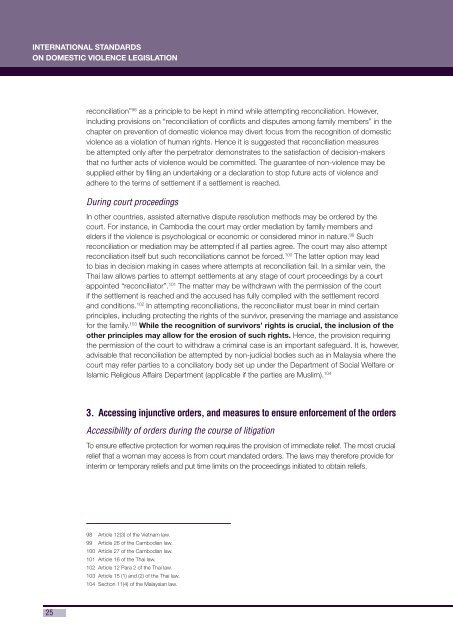Domestic Violence Legislation and its Implementation
Domestic Violence Legislation and its Implementation
Domestic Violence Legislation and its Implementation
Create successful ePaper yourself
Turn your PDF publications into a flip-book with our unique Google optimized e-Paper software.
INTERNATIONAL STANDARDS<br />
ON DOMESTIC VIOLENCE LEGISLATION<br />
25<br />
reconciliation” 98 as a principle to be kept in mind while attempting reconciliation. However,<br />
including provisions on “reconciliation of confl icts <strong>and</strong> disputes among family members” in the<br />
chapter on prevention of domestic violence may divert focus from the recognition of domestic<br />
violence as a violation of human rights. Hence it is suggested that reconciliation measures<br />
be attempted only after the perpetrator demonstrates to the satisfaction of decision-makers<br />
that no further acts of violence would be committed. The guarantee of non-violence may be<br />
supplied either by fi ling an undertaking or a declaration to stop future acts of violence <strong>and</strong><br />
adhere to the terms of settlement if a settlement is reached.<br />
During court proceedings<br />
In other countries, assisted alternative dispute resolution methods may be ordered by the<br />
court. For instance, in Cambodia the court may order mediation by family members <strong>and</strong><br />
elders if the violence is psychological or economic or considered minor in nature. 99 Such<br />
reconciliation or mediation may be attempted if all parties agree. The court may also attempt<br />
reconciliation <strong>its</strong>elf but such reconciliations cannot be forced. 100 The latter option may lead<br />
to bias in decision making in cases where attempts at reconciliation fail. In a similar vein, the<br />
Thai law allows parties to attempt settlements at any stage of court proceedings by a court<br />
appointed “reconciliator”. 101 The matter may be withdrawn with the permission of the court<br />
if the settlement is reached <strong>and</strong> the accused has fully complied with the settlement record<br />
<strong>and</strong> conditions. 102 In attempting reconciliations, the reconciliator must bear in mind certain<br />
principles, including protecting the rights of the survivor, preserving the marriage <strong>and</strong> assistance<br />
for the family. 103 While the recognition of survivors’ rights is crucial, the inclusion of the<br />
other principles may allow for the erosion of such rights. Hence, the provision requiring<br />
the permission of the court to withdraw a criminal case is an important safeguard. It is, however,<br />
advisable that reconciliation be attempted by non-judicial bodies such as in Malaysia where the<br />
court may refer parties to a conciliatory body set up under the Department of Social Welfare or<br />
Islamic Religious Affairs Department (applicable if the parties are Muslim). 104<br />
3. Accessing injunctive orders, <strong>and</strong> measures to ensure enforcement of the orders<br />
Accessibility of orders during the course of litigation<br />
To ensure effective protection for women requires the provision of immediate relief. The most crucial<br />
relief that a woman may access is from court m<strong>and</strong>ated orders. The laws may therefore provide for<br />
interim or temporary reliefs <strong>and</strong> put time lim<strong>its</strong> on the proceedings initiated to obtain reliefs.<br />
98 Article 12(3) of the Vietnam law.<br />
99 Article 26 of the Cambodian law.<br />
100 Article 27 of the Cambodian law.<br />
101 Article 16 of the Thai law.<br />
102 Article 12 Para 2 of the Thai law.<br />
103 Article 15 (1) <strong>and</strong> (2) of the Thai law.<br />
104 Section 11(4) of the Malaysian law.

















